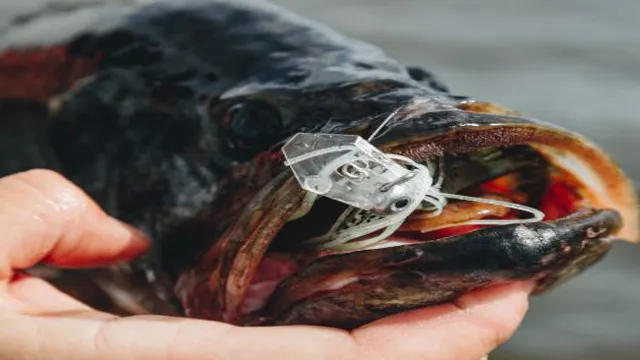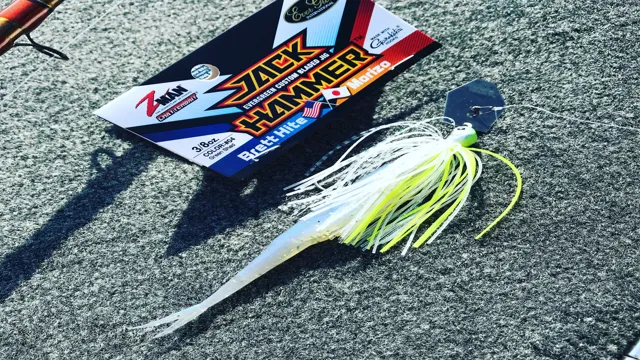Fishing enthusiasts are always looking for new and exciting ways to catch their favorite species. One technique that has gained popularity in recent years is fishing the Jackhammer. This fishing lure, created by Z-Man Fishing, combines the traditional vibration of a chatterbait with the flash and appeal of a spinnerbait, making it irresistible to fish.
But, with such a unique design, mastering the technique can be a challenge. In this blog post, we will dive into the techniques and tips for fishing the Jackhammer, helping you to reel in the catch of a lifetime. From the best gear to use, to the right retrieval speeds, and even the time of day to fish, we will cover it all.
So, get ready to learn and improve your skills as we explore the world of Jackhammer fishing.
Choosing the Right Gear
If you’re wondering how to fish the Jackhammer, the first step is to choose the right gear. This lure is notoriously versatile and can be used in a variety of settings, but there are a few things you should keep in mind. First, make sure you’re using a high-quality rod that’s sensitive enough to detect subtle movements.
A medium-heavy spinning rod with a fast action is a good choice, as it will provide enough backbone to hook the fish while still giving you enough control to fight it. Additionally, you’ll want to pair your rod with a reel that has a high gear ratio and a smooth drag system. This will allow you to retrieve the bait quickly and effectively, while still maintaining your connection to the fish.
Overall, the key to fishing the Jackhammer is to choose a well-balanced setup that allows you to feel every bite and set the hook with confidence.
Select the Right Rod and Reel
Selecting the right rod and reel for your fishing trip is crucial for having a successful day on the water. It’s important to consider the type of fish you are targeting, the location you are fishing, and your individual skill level. A heavy-duty rod and reel may be necessary for larger, stronger fish and for fishing in deeper waters, while a lightweight option may work better for smaller fish in shallower waters.
Additionally, your level of experience can play a role in your gear selection, as more advanced anglers may prefer using a baitcasting reel, while beginners may find a spinning reel easier to handle. Overall, taking the time to carefully select the appropriate gear for your specific fishing needs can greatly improve your chances of landing a catch.

Select the Right Line
When it comes to fishing, choosing the right gear is crucial to your success. One of the most important aspects of your setup is selecting the right line. There are many types of fishing lines available, each with their own unique properties.
Monofilament lines are a common choice for beginners, as they are easy to handle and tie knots with. However, if you’re looking for more sensitivity and less stretch, you may want to consider a braided or fluorocarbon line. Braided lines are known for their strength, while fluorocarbon lines are virtually invisible in the water, making them perfect for finicky fish.
Ultimately, the type of line you choose will depend on factors such as the type of fishing you’re doing and the specific conditions you’ll be facing. So, do your research and choose the line that’s right for you. Happy fishing!
Use the Right Jighead
When it comes to jigging, the right jighead is essential. It’s important to choose a jighead that matches the weight of the lure and the type of fishing you’re doing. If you’re fishing in shallow waters, a lighter jighead will work better.
Looking to catch bigger fish? A heavier jighead will provide better control and help you get your bait to where they are. Another important factor to consider is the shape of the jighead. Round or bullet-shaped jigheads are great for fishing in currents, while flat jigheads work better for fishing near the bottom.
So, don’t overlook the importance of choosing the right jighead for your fishing needs, as it can make all the difference in your angling success.
Tactics for the Jackhammer
Are you looking to master the art of fishing the jackhammer? This versatile lure has become a favorite among anglers due to its ability to imitate a variety of prey and attract strikes in both clear and murky waters. To start, choose a jig head that matches the size of your jackhammer and pair it with a soft plastic trailer. Cast your line and retrieve it with a steady, rhythmic motion, making sure to vary the speed and depth to mimic the movements of baitfish or invertebrates.
Another effective tactic is to fish the jackhammer around structure such as rocks, docks, and weed beds, bouncing it off the bottom and allowing it to fall into any crevices or pockets. Keep your rod tip pointed towards the water and use a sensitive line to detect any strikes, as the jackhammer’s fast action can result in lightning fast bites. With a little practice and patience, you’ll be snagging plenty of fish with the jackhammer in no time!
Master the Wobble
If you are looking to master the wobble, then tactics for the jackhammer are essential. The jackhammer, a popular dance move, involves bouncing up and down while rotating your hips, causing a wobbling movement. To start, loosen up your hips by performing a few hip circles.
Once you have mastered the basic movement, try adding a little more bounce to your steps. Don’t forget to engage your core to stabilize yourself and keep the movement controlled. Another tip is to play with the speed and intensity of your wobbling – slow it down or speed it up for different effects.
With practice and persistence, you can master the jackhammer and add some serious flavor to your dance moves. Keep at it, and don’t be afraid to get creative. Before you know it, you’ll be wobbling like a pro!
Match Your Retrieve Speed to the Water Temperature
When it comes to fishing with the Jackhammer, there are a few tactics that can greatly improve your chances of success. One important factor to consider is the water temperature. As a rule of thumb, you should match your retrieve speed to the temperature of the water.
Slower speeds are better for colder waters, while faster speeds are more effective in warmer temperatures. This is because fish tend to be more sluggish in colder water, so a slower, more methodical approach is necessary to entice them to bite. On the other hand, in warmer water, fish are more active and aggressive, so a faster retrieve can help trigger a strike.
By paying attention to the water temperature and adjusting your retrieve speed accordingly, you can improve your chances of landing a big catch with the Jackhammer.
Vary Your Retrieve
When it comes to using the ever-popular Jackhammer lure, varying your retrieve can make all the difference in hooking those big fish. There are several tactics you can try, such as a steady retrieve, a stop-and-go retrieve, or even a twitch-and-pause retrieve. Experimenting with different speeds and pauses can also help entice those finicky fish to strike.
It’s important to pay attention to the conditions and water temperature, as these can affect the fish’s behavior and feeding habits. By mixing up your retrieve, you’ll increase your chances of success and find out what works best for the fish in your area. So next time you’re out on the water with a Jackhammer lure, don’t be afraid to switch up your tactics and see what bites!
Location, Location, Location
When it comes to fishing the jackhammer lure, location can make or break your success. One of the best places to use this lure is around areas of structure, such as docks, piers, and rock piles, as these areas are likely to attract smaller baitfish and, in turn, larger predator fish. Additionally, you may want to focus your efforts on areas where the water temperature is slightly warmer, as this will encourage fish to be more active and more likely to strike your lure.
In terms of technique, it’s important to vary your retrieve speed and depth to determine what the fish are responding to best. Overall, understanding where the fish are and what they’re looking for can help you have a more successful day on the water when using the jackhammer lure.
Target Structure and Cover
“Location” When it comes to building structures, whether for commercial or residential purposes, there’s one mantra that’s been around for decades, and that is “location, location, location.” And it’s not just about being in a prime spot where you can attract more business or get a better view. The location of your property plays a crucial role in the structural integrity and safety of your building.
For example, building on a flood-prone area can lead to catastrophic consequences if not constructed properly. Moreover, understanding the topography, geology, and even the weather patterns in the area can help ensure that your building can withstand natural disasters and other possible hazards. So, before deciding on the structure and cover of your property, make sure to thoroughly assess the location to ensure a sound, safe, and secure structure that can withstand the test of time.
Fish the Drop-Offs and Edges
When it comes to fishing, the old adage “location, location, location” couldn’t be truer. One of the best spots to find fish is along the drop-offs and edges in a body of water. These areas can provide a great source of forage and cover for fish.
Drop-offs can be found around underwater structures and are typically marked by a sudden change in depth. As water becomes deeper, it often becomes cooler and more oxygenated, providing a comfortable environment for fish. Edges, on the other hand, are where shallow water meets deeper water, creating a transition zone that fish love to utilize.
By fishing along these areas, anglers can increase their chances of locating active fish and ultimately having a successful day on the water. So next time you’re out fishing, be sure to focus your efforts on the drop-offs and edges for the best results.
Final Thoughts
If you want to know how to fish the Jackhammer, the first step is to select the right size and color. The size of the bait should be chosen based on the fish species you are targeting. For example, if you are targeting largemouth bass, then opt for a 1/2 or 3/8-ounce size, and for smallmouth bass, choose a 1/4 or 3/8-ounce size.
The color selection should be based on the water clarity and the weather conditions. Always choose natural-looking colors like green pumpkin, black and blue, or watermelon when the water is clear, and brighter colors like white or chartreuse in murky water. After selecting the right size and color, the next step is to learn how to retrieve it.
The Jackhammer is most effective when retrieved slowly with a consistent, steady rhythmic motion. Don’t be afraid to experiment with different speeds, and always keep your rod tip down to help you feel the bait and detect any bites. With enough practice and patience, you’ll soon become a master at fishing the Jackhammer.
Conclusion
In conclusion, fishing with the jackhammer is not just about slamming the lure into the water and hoping for the best. It requires a delicate balance between technique, timing, and a little bit of luck. So, if you want to catch those prized fish with ease, make sure to master the art of the jackhammer.
And remember, always stay sharp and be ready to strike at any moment – just like a true jackhammer! Happy fishing!”
FAQs
What is the jackhammer lure and why is it so effective when fishing?
The jackhammer is a type of vibrating lure that creates an irregular, flashy movement in the water. This kind of action can trigger predatory fish to strike more readily than traditional lures.
What kind of rod and line should be used when fishing with a jackhammer lure?
The ideal rod for fishing a jackhammer lure is a medium-heavy power rod, with a fast action tip that can detect strikes and set the hook quickly. Use a braided or fluorocarbon line in the range of 15-25lb test for maximum sensitivity and casting distance.
How should the jackhammer lure be retrieved to maximize its effectiveness?
A steady retrieve with occasional pauses to allow the lure to sink and flutter is the most common method of fishing a jackhammer. Depending on the type of fish you’re targeting and the water clarity, varying the speed and depth of your retrieve can also be effective.
Can the jackhammer lure be used in freshwater, saltwater, or both?
The jackhammer lure can be used in both freshwater and saltwater environments, and is especially effective when fishing for bass, pike, and other predatory species.
Is it necessary to add additional bait or scent to the jackhammer lure?
While it’s not strictly necessary to add additional bait or scent to the jackhammer lure, some anglers may find success with adding a small piece of soft plastic or a scent attractant to the hook to increase their chances of a strike.
How can I prevent the jackhammer lure from getting snagged or caught on underwater obstacles?
Fishing with a lighter line and avoiding overly aggressive retrieves can help to minimize the risk of the jackhammer lure getting caught on underwater debris or vegetation. Additionally, using weedless hooks or other snag-resistant tackle can also be effective.
What should I do if I feel a strike when fishing with a jackhammer lure?
When you feel a strike, it’s important to set the hook quickly and firmly to avoid losing the fish. Keep tension on the line and reel steadily to bring the fish in, taking care to avoid any sudden jerks or movements that could pull the hook free.






